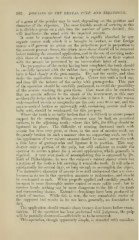Page 892 - My FlipBook
P. 892
902 DISEASES OF THE DEXTAL PULP, ASB TEEATMEXT.
of a graiu of the powder may be used, depending on the position and
character of the exposure. Tlie most feasible mode of arriving at this
is to divide a grain on a slab into the number of parts desired ; this
will familiarize the mind with the required amount.
It must be remembered that arsenic is rapidly absorbed by any
organic matter with which it is brought in contact, so that foreign
matter will prevent its action on the pulp-tissue just in proportion to
the amount present ; hence, the debris from decay should all be removed
before making the arsenical application, and in the use of covering mate-
rials those of a nature to absorb should be discarded or their contact
Avith the arsenic be prevented by an intermediate layer of metal.
The preparation of the cavity having been completed, the tooth should
be carefully invested Avith the rubber dam, especial care being taken to
have it bind closely at the gum-margin. Dry out the cavity, and then
make the application direct to the pulp. Cover this with a lead cap,
and then fill the balance of the cavity with gutta-percha. This part
of the operation should be carefully j)erformed, to avoid the possibility
of the arsenic rciichiug the gum-tissue. Care must also be exercised
that no arsenic adheres to the shank of the instrument, as this may
accidentallv hxlge where it is not desirable to have it. For this reason
wide-moutlied vessels as receptacles are the only ones fit to use, and the
narrow-necked bottles so universally sold, containing arsenic and car-
bolic acid, should be condemned for this purpose.
Where the tooth is so badly broken that it is difficult to secure proper
support for the retaining filling, recourse may be had, on proximal
surfiices, to the adjoining tooth ; where this fails, the filling should be
ligatured in place. The difficulty of treating fractured teeth with
arsenic has been very great, as these, in the case of anterior teeth, are
frequently broken in such a manner that no supporting walls are left.
Ail application of very minute amount should be made ; cover this with
a thin layer of gutta-percha and ligature it in position. This may
destroy only a portion of the pulp, but still sufficient to enable the
ojierator to secure a place for a second application, which generally is
reijuircd. A very neat mode of accomplishing this is suggested by Dr.
Kirk of Philadelphia : he uses the surgeon's rubber plaster where but
a portion of the tooth is left, carrying it round the tooth. It will adhere
satisfactorily for several days, or long enough to accomplish the object.
The destructive character of arsenic is so well understood that any care-
lessness in its use in this operation amounts to malpractice, and should
be condemned as such. AVhen ])roperly applied and carefully guarded,
no agent is more thorijughly under control or more safely used ; but in
careless hands nothing can l)e more dangerous to the life of the tooth
and surrounding tissues. Extensive sloughings have been produced by
a lack of caution. While this is true, the very remarkable stories of
the supposed bad results in its use have, generallv, no foundation in
fact.
The application should remain about twenty-four hours before exam-
ination. If the operation has been performed with judgment, the pulp
will lie partially destroyed—sufficiently so to be removed.
This operation, though apparently simple, is attended with consider-


